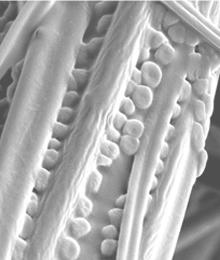An interview with Dr Lena Ciric
January 2020
Dr Lena Ciric, Senior Lecturer at University College London and member of the Microbiology Society discusses her research into the microbes that live in our buildings, and in water and ventilation systems and how her lab investigates where they are, how they survive and how they interact with surfaces in order to try and find ways to design healthier indoor spaces.

Tell us more about your research
We often think of microbes living in our bodies when we have a cold or a bacterial infection. Sometimes we think of them lurking in toilets, on chopping boards and in hospitals. But, in reality, microbes are always in and on us and all over the objects we interact with. These organisms have been around much longer than we have, and we and our world have evolved together with them. Most microbes cause us no harm but there are a few out there that can.
At the Healthy Infrastructure Research Group at University College London, we look at the microbes that live in our buildings, and in water and ventilation systems. We investigate where they are, how they survive and how they interact with surfaces. We also try to find ways to design healthier indoor spaces.
Who are the key stakeholders you work with?
A lot of our projects involve working with hospitals. This is because the risk of picking up a microbial infection in a hospital is higher, as people are more vulnerable when they are unwell and hospitals are full of dangerous microbes. Many of these microbes are resistant to antibiotics, which means it is more difficult to treat the infections they cause. We have been working with Great Ormond Street Hospital to develop water filters which are able to kill bacterial cells in seconds. We are now working to translate the technology for the eradication of viruses by air filtration. We hope that these filters can reduce the spread of dangerous microbes in hospital water and air.
How are you helping to understand bacteria in industry?
We have been looking at how biofiltration, a drinking water treatment method that filters water through a thick layer of sand, contributes to the removal of antibiotics and antibiotic resistance genes. Antibiotics get into natural water systems from sewage and agriculture. Antimicrobial resistance genes allow bacteria to survive in the presence of antibiotics. They can also be passed from one type of bacterium to another, which means that resistance can spread quickly. We have set up lab-scale biofilters and used different types of sand and carbon-based material in them to filter water. We have found that the biofilters that are the best at removing antibiotics can also increase the concentration of antimicrobial resistance genes in the treated water. This is something that water treatment facilities should consider.
Why is this research important to microbiology?
These insights will help us to understand how the microbes in our vicinity can affect our health and design in order for us to create better indoor spaces for the future.
If you are a member of the Society and would like to find out more about how you can get involved with Society activities and/or showcase your research, please email us at [email protected].


